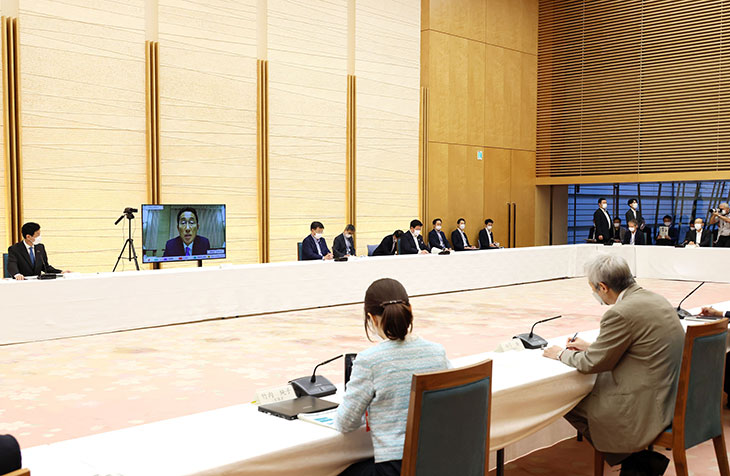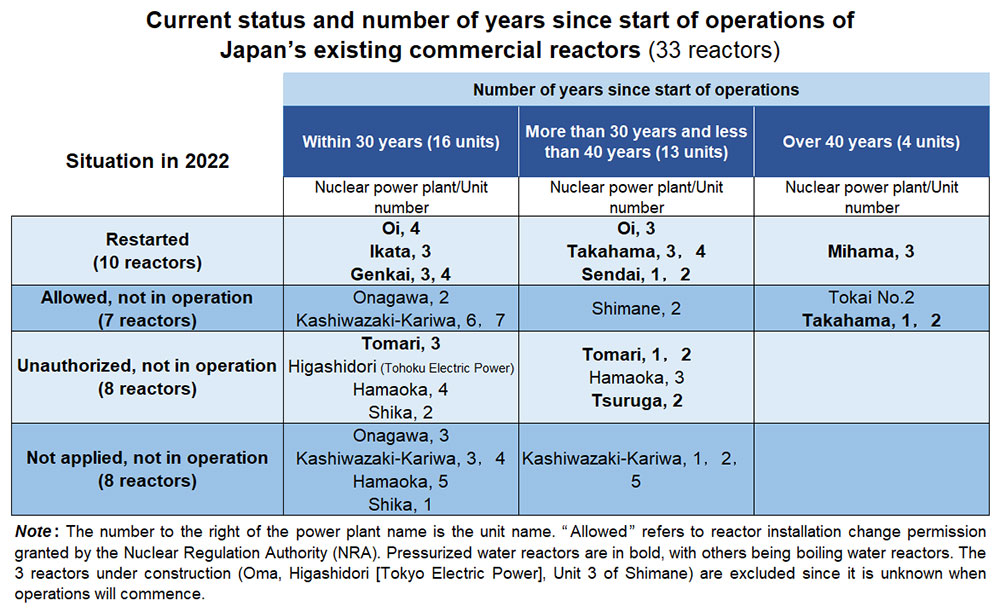The Future of Nuclear Energy Policy: The Current Administration Claims of “Policy Change” Are Without Merit

At the second meeting of the GX (Green Transformation) Implementation Council held on August 24, 2022, Prime Minister Kishida Fumio said, “[…] items requiring future political decisions concerning nuclear power were also put forward, such as combined efforts by the concerned parties to resume operations, maximum utilization of existing nuclear power plants including the extension of their operation period with ensuring their safety being a major precondition, and development and construction of next-generation advanced reactors that incorporate new safety mechanisms.”
Photo: Cabinet Public Affairs Office
Kikkawa Takeo, Vice President, International University of Japan
Key points
- Electricity providers show no signs of working with next-generation advanced reactors
- Old nuclear reactors to be dismantled when building next-generation advanced reactors
- Extension of operating period for existing nuclear power plants is unsuitable

Prof. Kikkawa Takeo
Prime Minister Kishida Fumio and the Minister of Economy, Trade and Industry Nishimura Yasutoshi spoke about nuclear energy at the GX (Green Transformation) Implementation Council in August 2022, and some media outlets made a big deal of it and called it a “changed nuclear energy policy.” The Kishida administration listed the following two items for which political decisions are needed before the end of 2022 in order to resolve the delays in nuclear energy policy: (1) development and construction of next-generation advanced reactors and (2) maximizing the use of existing nuclear power plants, including an extension of their operating periods.
Particular attention was paid to item (1). It marked a change to the previous policy of “no replacement (rebuilding) or new building of nuclear power plants” and was praised as a substantial step toward the construction of next-generation advanced reactors.
Is that really the case? Cutting it short, I think it is too early to call this a policy change. Firstly, there is no mention of what (which types of innovative furnace) will be built where (which locations) by whom (which operators). Secondly, the reactions of electricity providers have been cool, and they have not taken any concrete action for the construction of next-generation advanced reactors in Japan.
In the past, whenever the government seriously changed its energy policy, this was preceded by concrete action by electricity providers that connect with the policy change.
For example, in October 2020, then Prime Minister Suga Yoshihide announced the aim to achieve carbon neutrality (net zero greenhouse gas emissions) by 2050. Just before that, JERA, the largest thermal power generation company in Japan, switched from coal-fired to ammonia-fired power as well as announced their “carbon-free thermal power vision” of changing their liquefied natural gas (LNG)-fired power into hydrogen thermal power. They specified that even with the expansion of fluctuating power sources such as wind and solar power, this would enable thermal power generation as a backup that does not emit CO2.
This time, however, things look different. Despite the talk about constructing next-generation advanced reactors, there is no concrete action by electricity providers that resonates with that. Four power companies, including Kansai Electric Power, will be working together in the project to develop the next-generation pressurized water reactor “SRZ-1200” announced by Mitsubishi Heavy Industries, but the goal is only “development” while “construction” is not in the picture. Kansai Electric Power’s President Mori Nozomu, who should be a key player if actual construction were to take place, spoke in a recent interview and only said that they would maintain the existing seven-reactor system in the future.
The absence of specific references to “who, where, and what” seems to be a reflection of these circumstances.
It makes sense to have a nuclear energy policy that includes building next-generation advanced reactors. The reason is that it reduces the dangers of nuclear power plants. If nuclear is to be used as a power source, regardless of our degree of dependence on it, risk minimization is an absolute prerequisite. There is no doubt that using new reactors is better.
Yet, there are two things to keep in mind here.
Firstly, in Japan today, it is extremely difficult to find locations for new nuclear power plants, and realistically, next-generation advanced reactors will have to be constructed on the same sites as existing nuclear power plants.
Secondly, building next-generation advanced reactors does not necessarily mean more nuclear power plants. Since the intrinsic value of next-generation advanced reactors construction lies in reducing danger, older nuclear reactors that are more dangerous should be actively decommissioned in parallel with the construction. In other words, the term “new building” refers to next-generation advanced reactors built on the same sites as existing nuclear power plants, so we should use the term “replace” since it is actually about replacing old reactors with new reactors.
In 2018, when the 5th Strategic Energy Plan was adopted by Cabinet decision, Japan shifted in the direction of making renewable energy as the main power source. Renewable energy as the main power source is synonymous with “nuclear as the secondary power source.” Given these circumstances, the main focus of Japan’s nuclear energy policy ought to be to gradually decrease dependence on nuclear energy while going ahead with replacements.
In proceeding with the replacements, there are two types of reactors that I would like to draw attention to, namely next-generation light water reactors and high-temperature gas-cooled reactors (HTGR).
Japanese nuclear power plant facilities are far from state-of-the-art. The boiling water reactors, which account for more than half of the total (17 reactors), include four state-of-the-art advanced boiling water reactors (ABWR) (Kashiwazaki-Kariwa Units 6 and 7 of Tokyo Electric Power Company Holdings, Hamaoka Unit 5 of Chubu Electric Power, Shika Unit 2 of Hokuriku Electric Power Company). Yet the other half of pressurized water reactors (16 reactors) include no state-of-the-art advanced pressurized water reactors (APWR) or the state-of-the-art “AP1000” pressurized water reactors.
In China, AP1000 reactors and European pressure reactors (EPR) have been in operation since 2018. All 10 reactors so far restarted in Japan are pressurized water reactors and old (see Table). In order to rectify this situation, it is important to replace older pressurized water reactors with next-generation light water reactors.
Among the so-called “new reactors” other than the next-generation light water reactors, there are high hopes for HTGR. This is because it can produce not only electricity but also hydrogen by using heat of more than 900 degrees centigrade. Hydrogen is a key technology that will determine the fate of Japan’s carbon-neutrality strategy. The problem is that the production cost is high.
Most of the ongoing hydrogen projects plan for hydrogen production overseas, where charges for green power derived renewable energy are cheaper than in Japan, to lower production costs. But that would mean importing hydrogen, which would not solve the low energy self-sufficiency that is Japan’s Achilles heel. If HTGR are built domestically, it will pave the way for low-cost, high-volume hydrogen production. That opens up for the prospect of domestic production of carbon-free hydrogen.
We are approaching the end of the year when the Kishida administration is due to make a decision on the construction of next-generation advanced reactors. However, no concrete discussions have been conducted on the crucial issues of “who, where, and what to build.”
By contrast, concrete proposals have been made for extensions of operating periods of existing nuclear power plants. This is a serious situation. As can be seen from the Table, Japan has many nuclear reactors “awaiting extension” that have been in operation for more than 30 years. If these get extensions, electricity providers will probably feel that there is no need to build next-generation advanced reactors at a high cost of 1 trillion yen. Electricity providers’ cool stance on building next-generation advanced reactors may be seen as a testament to this.
The argument for extending the operating periods of existing nuclear power plants, which is detrimental to reducing the dangers of those plants, is widespread, and we are seeing a progressing worst-case scenario where the next-generation advanced reactors that ought to be constructed are receding into the background. There is little time left, but there is an urgent need to revise the nuclear energy policy.
The state needs to demonstrate its leadership by the end of 2022. For example, it is conceivable that Kansai Electric Power, in collaboration with Chubu Electric Power and Kyushu Electric Power, can replace the nuclear reactors at Mihama Plant by decommissioning the old Unit 3 pressurized water reactors and construct Unit 4 with next-generation light water reactors. Another possible scenario is that the Japan Atomic Power Company (JAPC) and Kansai Electric Power build HTGR at the vacant lots where the JAPC Tsuruga Plant’s Units 3 and 4 are planned, thus allowing for hydrogen power generation as well. If a specific direction like this is put forward, then I am certain that the policy change can be regarded as real.
Translated by The Japan Journal, Ltd. The article first appeared in the “Keizai kyoshitsu” column of The Nikkei newspaper on 7 December 2022 under the title, “Genpatsu seisaku no Yukue (I): Gen-seiken, ‘Seisakutenkan’ niwa Ataisezu (The Future of Nuclear Energy Policy (I): The Current Administration Claims of “Policy Change” Are Without Merit).” The Nikkei, 7 December 2022. (Courtesy of the author)
Keywords
- Kikkawa Takeo
- International University of Japan
- nuclear energy
- nuclear power
- nuclear power plants
- next-generation advanced reactors
- HTGR
- ABWR
- old nuclear reactors
- electricity providers
- renewable energy
